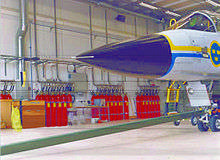Clean agent FS 49 C2

Clean agent FS 49 C2 is an environmentally engineered, human safe, fast extinguishing Clean Agent fire extinguishing gas for gaseous fire suppression installed in a suited fire suppression system. It is a gaseous solution of 60-80% tetrafluoroethane (R-134a), 10-30% pentafluoroethane (R-125) and 10-30% carbon dioxide (CO2). The Clean agent FS 49 C2 is an extinguishing gas mixture that suppresses fire while maintaining breathable concentrations of oxygen in the air. This makes it possible to extinguish a fire with less danger to people in the room at extinguishing concentrations in contrast to pure carbon dioxide (CO2) based fire suppression system which is deadly to humans when released. In the beginning the gas was called Halotron II B/FS49C2 but later only the name FS 49 C2 is used. Former fire chief Einar Gjessing made an article[1] about the product to inform firemen how this gas works in case they need to enter a fire site with FS 49 C2.
Thermal fire suppression
FS 49 C2 acts similarly to an inert gas. The heat produced from the combustion process is absorbed by the extinguishant. This mechanism is consistent with the observation that there is no decrease in the fire heat release rate as long as the amount of extinguishment agent added is below a certain limit, and as soon as more extinguishment agent is added the fire is then extinguished.
The difference from inert gases and FS 49 C2 is that it takes less gas to suppress a fire, and therefore less space is consumed by the storage of the gas for the fire extinguishing system. How much space is saved will depend on the pressure used when filling the cylinder. It may vary between a 50-90% saving of storage space.
Consistence
The gas consists of tetrafluoroethane, pentafluoroethane and carbon dioxide.
Its physical properties are similar to those of Halon 1301.
Halon Replacement
The agent is believed to cause considerably less damage to the environment. The main component of FS 49 C2 is the most widely used replacement gas for refrigeration systems, characterized by zero Ozone Depletion Potential (ODP) factor. The FS 49 C2 is suitable to replace Halon 1301 as a "drop in" upgrade of existing Halon systems.
If a room is filled 12% by FS 49 C2 it is sufficient to suppress a flame based fire. The time a system use to release the gas into a room is: Marine based installations: 8 seconds. Land based installations: 10 seconds.
Even though the FS 49 C2 gas itself doesn't leave dangerous gasses after being released into air it is recommended to use a SCBA - Self-contained breathing apparatus when entering a room after a fire because after a fire process it will release different potential harmful gasses into the air.
The Montreal protocol ban of Halon gases
UNEP banned the use of Halon gases in the Montreal Protocol treaty in 1987 due to the Ozone depletion and the Ozone depleting effect of Halon gases. The development countries were granted with extension in their permit to still be using Halon until 2010. It is after 2010 considered important by UNEP that also the development countries replace their Halon with Ozone friendly alternatives according to the signed treaty.
References
- ↑ "Information article for fire fighters by former fire chief Einar K. Gjessing". Brannmannen. 4 September 2002.